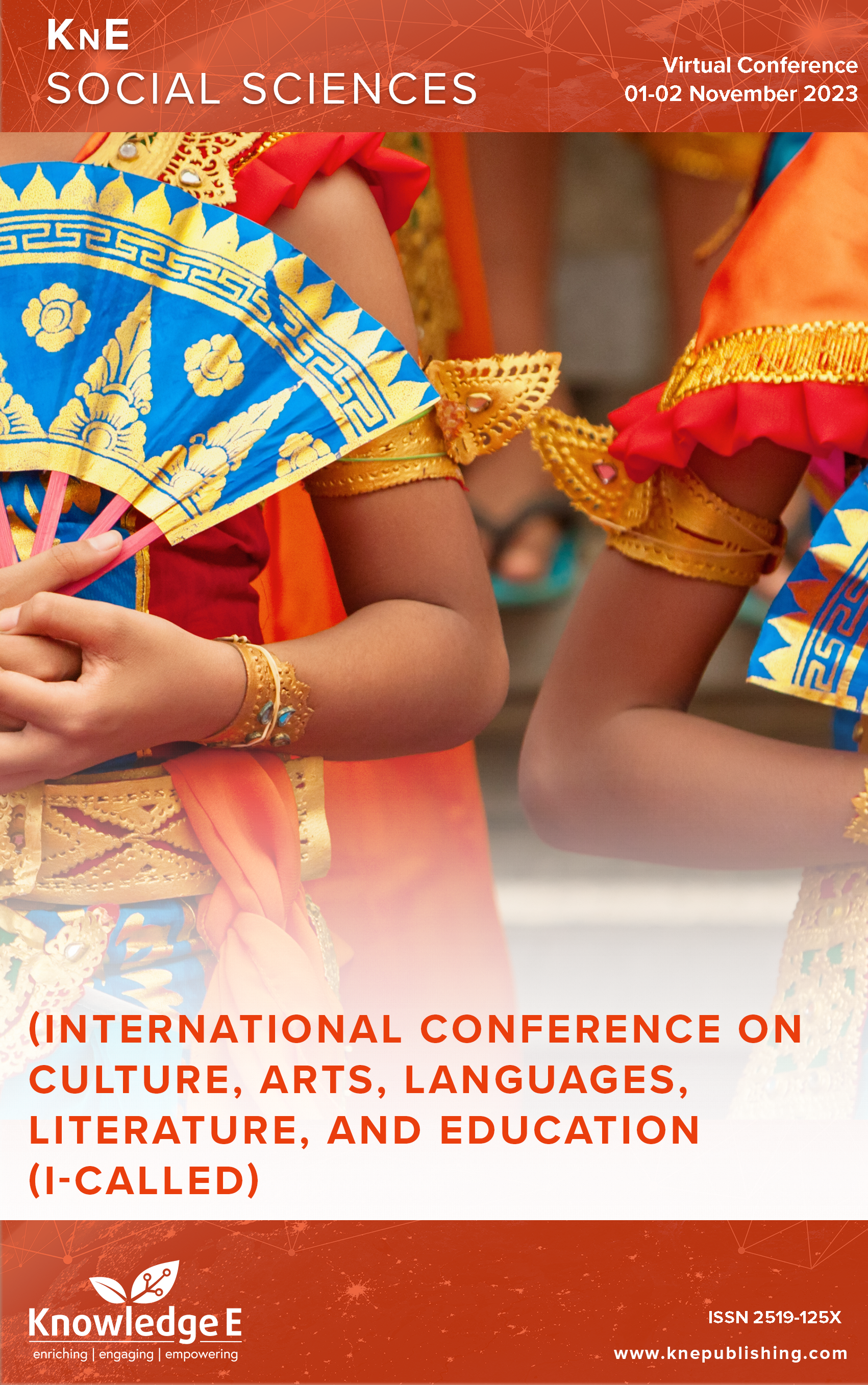Functional Typology Structure of Ethnicity and Culture Toward Regional Language Learning in Aceh Singkil District
DOI:
https://doi.org/10.18502/kss.v9i9.15660Abstract
Aceh Singkil is an economically successful area with many enticing tourist attractions, such as natural, ethnic, and maritime. This region, which is bordered by the sea and split by a major river known as the Lae Souraya, is home to several historical and cultural attractions. The existence of natural resources and cultural attractions persuades the local government to formulate the culture as an interesting package for the visitor. This article examines the role and resources of Aceh Singkil’s natural and cultural heritage that are currently, but not properly, used. According to this typology, Aceh Singkil has phenomenal tourism and cultural attraction spots, which include natural tourist attractions, art and cultural performances, artificial natural (engineering) and important cultural places, royal historical heritage sites, important spiritual sites, spiritual values, local genius, and traditional culinary delights. Following a field investigation, researchers found issues such as how to operate and exploit these cultural sites for sustainable tourist growth. What typology may be used to depict tourism and cultural attractions in Aceh Singkil? This study seeks to identify and deconstruct examples of operating and exploiting these resources for the development of sustainable cultural tourism, as well as to build a typology capable of representing Aceh Singkil’s tourist attractions. Theoretical and practical issues that indicate the uniqueness of regional ethno-cultural tourism are examined. Based on this data, experts believe that an ethno-historically based ethnocultural tourism model is required. Moreover, these findings and field investigations are critical to create an ethnocultural tourism model that pays special attention to the cultural traits of the Aceh Singkil people and national nature for both locals and visitors from other countries. The objective of establishing this model is to assist in the development and introduction of sustainable cultural attraction for visitors, the creation of new employment for people, the rise in sales of tourism and cultural products, and, of course, the improvement of tourism and art cultural infrastructure in the region.
Keywords: ethnocultural, ethno-historically, tourism, cultural heritage, characteristics of Aceh Singkil
References
Khan AH, Haque A, Rahman MS. What makes tourists satisfied? An empirical study on Malaysian Islamic tourist destination. Middle-East Journal of Scientific Research. 2013;14(12):1631-1637.
Aswita D, Suryadarma IGP, Suyanto S. Local wisdom of Sabang island society (Aceh, Indonesia) in building ecological intelligence to support sustainable tourism. Sustainable Development, Tadbir Magazine. 2018;22(2):393-402. DOI: https://doi.org/10.30892/gtg.22210-297
Neuhofer B, Buhalis D, Ladkin A. Smart technologies for personalized experiences: A case study in the hospitality domain. Electronic Markets. 2015;25(3):243-254. https://doi.org/10.1007/s12525-015-0182-1 DOI: https://doi.org/10.1007/s12525-015-0182-1
Baloglu S, McCleary KW. A model of destination image formation. Annals of Tourism Research. 1999;26(4):868-897. https://doi.org/10.1016/S0160-7383(99)00030-4 DOI: https://doi.org/10.1016/S0160-7383(99)00030-4
Stylos N, Vassiliadis CA, Bellou V, Andronikidis A. Destination images, holistic images and personal normative beliefs: Predictors of intention to revisit a destination. Tourism Management. 2016;53:40-60. https://doi.org/10.1016/j.tourman.2015.09.006 DOI: https://doi.org/10.1016/j.tourman.2015.09.006
Zhang H, Xu F, Leung HH, Cai LA. The influence of destination-country image on prospective tourists’ visit intention: Testing three competing models. Asia Pacific Journal of Tourism Research. 2016;21(7):811-835. https://doi.org/10.1080/10941665.2015.1075566 DOI: https://doi.org/10.1080/10941665.2015.1075566
Allameh SM, Khazaei Pool J, Jaberi A, Salehzadeh R, Asadi H. Factors influencing sport tourists’ revisit intentions: The role and effect of destination image, perceived quality, perceived value and satisfaction. Asia Pacific Journal of Marketing and Logistics. 2015;27(2):191-207. https://doi.org/10.1108/APJML-12-2013-0159 DOI: https://doi.org/10.1108/APJML-12-2013-0159
Papadimitriou D. Service quality components as antecedents of satisfaction and behavioral intentions: The case of a Greek carnival festival. Journal of Convention & Event Tourism. 2013;14(1):42-64. https://doi.org/10.1080/15470148.2012.755885 DOI: https://doi.org/10.1080/15470148.2012.755885
Petrick JF. The roles of quality, value, and satisfaction in predicting cruise passengers’ behavioral intentions. Journal of Travel Research. 2004;42(4):397-407. https://doi.org/10.1177/0047287504263037 DOI: https://doi.org/10.1177/0047287504263037
Petrick JF, Backman SJ. An examination of the construct of perceived value for the prediction of golf travelers’ intentions to revisit. Journal of Travel Research. 2002;41(1):38-45. https://doi.org/10.1177/004728750204100106 DOI: https://doi.org/10.1177/0047287502041001005
Žabkar V, Brencic MM, Dmitrovic T. Modelling perceived quality, visitor satisfaction and behavioural intentions at the destination level. Tourism Management. 2010;31(4):537-546. https://doi.org/10.1016/j.tourman.2009.06.005 DOI: https://doi.org/10.1016/j.tourman.2009.06.005
Tihabsah T. Aceh memiliki bahasa, suku, adat dan beragam budaya. Jurnal Serambi Akademica. 2022;10(7):738-748. https://doi.org/10.32672/jsa.v10i7.4937
Efendi Ja. Strategi majelis adat aceh (maa) dalam melestarikan budaya Aceh. Al-Idarah: Jurnal Manajemen dan Administrasi Islam. 2018;2(2):147-166. https://doi.org/10.22373/al-idarah.v2i2.4422 DOI: https://doi.org/10.22373/al-idarah.v2i2.4422
Hair JF, Black WC, Babin BJ, Anderson RE, Tatham R. Multivariate data analysis. Upper Saddle River, NJ: Pearson; 2010.
Almerico GM. Food and identity: Food studies, cultural, and personal identity. Journal of International Business and Cultural Studies. 2014;8(1):1-8.
Sjamsuddin H. Metodologi sejarah. Yogyakarta: Ombak; 2017.
Anismar A. Model pariwisata Islami di kabupaten Aceh Singkil. Jurnal Jurnalisme. 2019;9(1):84-92. https://doi.org/10.29103/jj.v9i1.3100 DOI: https://doi.org/10.29103/jj.v9i1.3100
Flier AY. Kulturologiya dlya kulturologov: Uchebnoe posobie dlya magistrantov, aspirantov e soeskateley, a tak zheprepodavateley kulurologii. 2 isdanie,ispravlennoe b dopolnennoe. Moscow: Moscow State Art and Cultural University; 2010.
Zorin IV, Kaverina TP, Kvartal’nov VA. Menedzhment turisma. Turism kakvid deyatelnosti
[The management of tourism tourism as an activity]. Moscow: Moscow “Finance Stat “publ; 2001.
Fedorova SN, Fedorova GA, Konopleva NA. Functional typological structure of ethnic and cultural tourism in the republic of Sakha (Yakutia). Amazonia Investiga. 2020;9(25):71-77.
Sutrisno IH, Akob B, Navia ZI, Nuraini N, Suwardi AB. Documentation of ritual plants used among the Aceh tribe in Peureulak, East Aceh district, Indonesia. Biodiversitas Journal of Biological Diversity. 2020;21(11):4990-4998. https://doi.org/10.13057/biodiv/d211102 DOI: https://doi.org/10.13057/biodiv/d211102
Sada M, Jumari J. Etnobotani tumbuhan upacara adat etnis Ngadha di Kecamatan Jerebu’u Kabupaten Ngada, Propinsi Nusa Tenggara Timur. Jurnal Saintek Lahan Kering. 2018;1(2):19-21. https://doi.org/10.32938/slk.v1i2.503 DOI: https://doi.org/10.32938/slk.v1i2.503
Mutaqin AZ, Astriani W, Husodo T, Partasasmita R. Pemanfaatan tumbuhan untuk beberapa upacara adat oleh masyarakat desa Pangandaran kecamatan Pangandaran kabupaten Pangandaran. Jurnal Pro-Life. 2018;5(1):496-505. https://doi.org/10.33541/jpvol6Iss2pp102 DOI: https://doi.org/10.33541/jpvol6Iss2pp102

